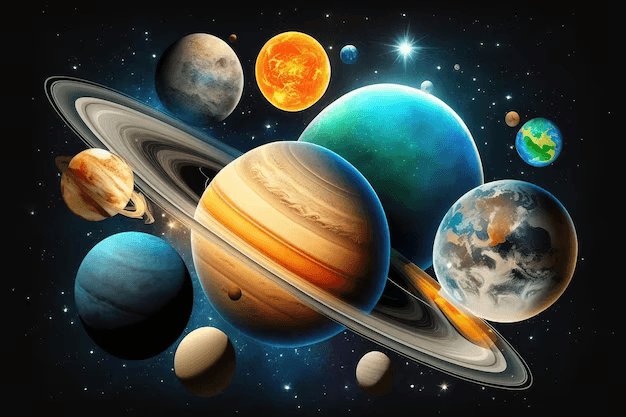Introduction: The Enigmatic World of Budh
Nestled within our solar system, the Budh Planet, commonly known as Mercury, holds a unique position as the closest planet to the Sun. In this exploration, we embark on a journey to unravel the secrets of this small, rocky world and understand its significance in the cosmic tapestry.
Budh’s Identity: Mercury, the Swift Messenger
The Roman Messenger God
In Roman mythology, Mercury is the swift-footed messenger of the gods, and the planet inherits its name due to its rapid orbit around the Sun. This celestial speedster completes an orbit in just about 88 Earth days, showcasing its remarkable velocity.
Characteristics of Budh
Mercury is a terrestrial planet, akin to Earth, Venus, and Mars, but it stands out with distinctive features. It boasts a surface riddled with craters, a negligible atmosphere, and extreme temperature variations due to its proximity to the Sun.
Orbital Dynamics: Budh’s Dance Around the Sun
Eccentric Orbit and Elongated Days*
Mercury’s orbit is elliptical, with a noticeable eccentricity. This eccentric orbit contributes to its extreme temperature fluctuations, ranging from scorching highs during the day to freezing lows at night. Despite its proximity to the Sun, Mercury’s rotation is slow, with a day on the planet lasting approximately 176 Earth days.
Synchronous Rotation and Spin-Orbit Resonance
One of the peculiarities of Mercury’s rotation is its synchronous spin-orbit resonance. It rotates three times on its axis for every two orbits around the Sun. This unique dance creates a complex interplay between its rotational and orbital motions.
Extreme Temperatures: Surviving the Solar Furnace and Cold Nights
Sunlit Scorching Days*
Due to its proximity to the Sun and lack of a substantial atmosphere to distribute heat, the sunlit side of Mercury experiences searing temperatures, soaring to around 430 degrees Celsius (800 degrees Fahrenheit). Surface materials, such as rocks and metals, absorb this intense heat, contributing to the hostile conditions.
Frigid Darkness in the Shadows*
Conversely, the lack of a protective atmosphere also means that Mercury has no insulation to retain heat during its long, shadowed nights. In these periods, temperatures plummet to approximately -180 degrees Celsius (-290 degrees Fahrenheit), creating a stark temperature dichotomy between day and night.
Surface Features: Craters, Plains, and Scarps
Impact Craters: A Pockmarked Landscape
Mercury’s surface is a testament to the relentless bombardment it has endured over billions of years. Impact craters, ranging from small pockmarks to large basins, cover the planet. The largest among them is the Caloris Basin, a vast impact structure that spans approximately 960 miles (1,550 kilometers) in diameter.
Smooth Plains and Scarps
Intermingled with craters are expansive smooth plains, believed to result from volcanic activity in Mercury’s distant past. Additionally, prominent scarps, or cliffs, traverse the landscape. These scarps are thought to be the result of the planet’s surface contracting as it cooled, creating dramatic geological features.
Lack of Atmosphere: The Silent Void of Budh
A Tenuous Exosphere*
Mercury’s atmosphere, or more accurately, its exosphere, is exceptionally thin. Composed mainly of trace amounts of helium, hydrogen, and oxygen, it is incapable of retaining heat or supporting traditional weather patterns. The lack of a substantial atmosphere exposes the planet’s surface to the full force of solar radiation and cosmic rays.
Absence of Weather and Wind*
The absence of a significant atmosphere means Mercury does not experience weather phenomena like storms, clouds, or winds. Its surface is perpetually exposed to the harsh conditions of space, making it a desolate and barren world.
Origin and Composition: Tracing the Roots of Budh
Building Blocks of the Solar System*
Mercury, like other terrestrial planets, formed from the primordial disk of gas and dust surrounding the young Sun. Its composition, primarily composed of rock and metal, reflects the materials present in the early solar system.
Iron Core: A Surprising Revelation*
One of Mercury’s most intriguing features is its disproportionately large iron core. This dense core makes up about 60% of the planet’s mass and is believed to have formed early in its history. The presence of such a substantial iron core raises questions about the planet’s formation and the processes that shaped its interior.
Missions to Budh: Probing the Secrets of the Innermost Planet
Mariner 10: The Pioneer*
In the 1970s, NASA’s Mariner 10 made history by becoming the first spacecraft to visit Mercury. It conducted three flybys, capturing the first close-up images of the planet and providing crucial data about its surface features, magnetic field, and tenuous atmosphere.
MESSENGER Mission: A Comprehensive Study*
The MESSENGER (MErcury Surface, Space ENvironment, GEochemistry, and Ranging) spacecraft, launched in 2004, marked a significant advancement in our understanding of Mercury. It orbited the planet for over four years, meticulously mapping its surface, studying its magnetic field, and shedding light on its geological history.
Conclusion: Unraveling Budh’s Secrets and Beyond
As we conclude our exploration of the Budh Planet, we find a world of extremes, from blazing days to freezing nights, with a surface scarred by eons of cosmic bombardment. Mercury’s unique characteristics and mysteries continue to captivate scientists and space enthusiasts, emphasizing the importance of further exploration to unveil the secrets of our celestial neighbors. In the vast expanse of our solar system, each planet holds its own story, contributing to the intricate narrative of the cosmos.
